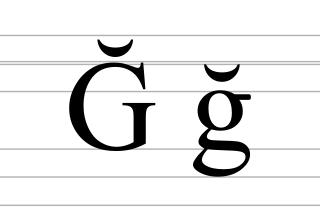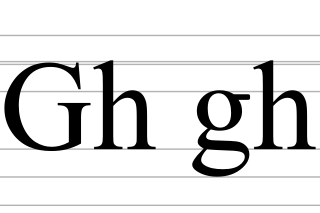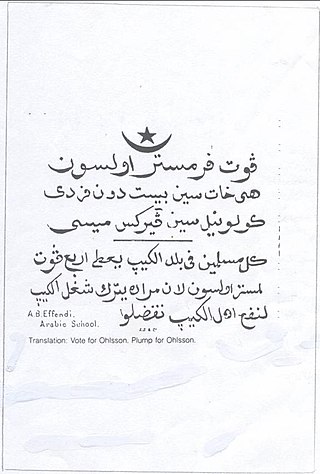
The Arabic alphabet, or Arabic abjad, is the Arabic script as specifically codified for writing the Arabic language. It is written from right-to-left in a cursive style, and includes 28 letters, of which most have contextual letterforms. The Arabic alphabet is considered an abjad, with only consonants required to be written; due to its optional use of diacritics to notate vowels, it is considered an impure abjad.
Gamma is the third letter of the Greek alphabet. In the system of Greek numerals it has a value of 3. In Ancient Greek, the letter gamma represented a voiced velar stop IPA:[ɡ]. In Modern Greek, this letter normally represents a voiced velar fricative IPA:[ɣ], except before either of the two front vowels, where it represents a voiced palatal fricative IPA:[ʝ]; while /g/ in foreign words is instead commonly transcribed as γκ).
The Hebrew alphabet, known variously by scholars as the Ktav Ashuri, Jewish script, square script and block script, is traditionally an abjad script used in the writing of the Hebrew language and other Jewish languages, most notably Yiddish, Ladino, Judeo-Arabic, and Judeo-Persian. In modern Hebrew, vowels are increasingly introduced. It is also used informally in Israel to write Levantine Arabic, especially among Druze. It is an offshoot of the Imperial Aramaic alphabet, which flourished during the Achaemenid Empire and which itself derives from the Phoenician alphabet.

Ğ is a Latin letter found in the Turkish and Azerbaijani alphabets as well as the Latin alphabets of Zazaki, Laz, Crimean Tatar, Tatar, and Kazakh. It traditionally represented the voiced velar fricative or the voiced uvular fricative. However, in Turkish, the phoneme has in most cases been reduced to a silent letter, serving as a vowel-lengthener.

Guttural R is the phenomenon whereby a rhotic consonant is produced in the back of the vocal tract rather than in the front portion thereof and thus as a guttural consonant. Speakers of languages with guttural R typically regard guttural and coronal rhotics to be alternative pronunciations of the same phoneme, despite articulatory differences. Similar consonants are found in other parts of the world, but they often have little to no cultural association or interchangeability with coronal rhotics and are (perhaps) not rhotics at all.
Mizrahi Hebrew, or Eastern Hebrew, refers to any of the pronunciation systems for Biblical Hebrew used liturgically by Mizrahi Jews: Jews from Arab countries or east of them and with a background of Arabic, Persian or other languages of Asia. As such, Mizrahi Hebrew is actually a blanket term for many dialects.
While many languages have numerous dialects that differ in phonology, contemporary spoken Arabic is more properly described as a continuum of varieties. This article deals primarily with Modern Standard Arabic (MSA), which is the standard variety shared by educated speakers throughout Arabic-speaking regions. MSA is used in writing in formal print media and orally in newscasts, speeches and formal declarations of numerous types.
Qoph is the nineteenth letter of the Semitic abjads, including Phoenician qōp 𐤒, Hebrew qūp̄ ק, Aramaic qop 𐡒, Syriac qōp̄ ܩ, and Arabic qāf ق.
Gimel is the third letter of the Semitic abjads, including Phoenician gīml 𐤂, Hebrew gīmel ג, Aramaic gāmal 𐡂, Syriac gāmal ܓ, and Arabic ǧīm ج. Its sound value in the original Phoenician and in all derived alphabets, except Arabic, is a voiced velar plosive ; in Modern Standard Arabic, it represents either a or for most Arabic speakers except in Northern Egypt, the southern parts of Yemen and some parts of Oman where it is pronounced as the voiced velar plosive.
Heth, sometimes written Chet or Ḥet, is the eighth letter of the Semitic abjads, including Phoenician ḥēt 𐤇, Hebrew ḥēt ח, Aramaic ḥēṯ 𐡇, Syriac ḥēṯ ܚ, and Arabic ḥāʾ ح.
Ayin is the sixteenth letter of the Semitic scripts, including Phoenician ʿayin 𐤏, Hebrew ʿayin ע, Aramaic ʿē 𐡏, Syriac ʿē ܥ, and Arabic ʿayn ع.
The Arabic chat alphabet, Arabizi, Arabeezi, Arabish, Franco-Arabic or simply Franco refer to the romanized alphabets for informal Arabic dialects in which Arabic script is transcribed or encoded into a combination of Latin script and Arabic numerals. These informal chat alphabets were originally used primarily by youth in the Arab world in very informal settings—especially for communicating over the Internet or for sending messages via cellular phones—though use is not necessarily restricted by age anymore and these chat alphabets have been used in other media such as advertising.
The phonology of the Persian language varies between regional dialects, standard varieties, and even from older variates of Persian. Persian is a pluricentric language and countries that have Persian as an official language have separate standard varieties, namely: Standard Dari (Afghanistan), Standard Iranian Persian (Iran) and Standard Tajik (Tajikistan). The most significant differences between standard varieties of Persian are their vowel systems. Standard varieties of Persian have anywhere from 6 to 8 vowel distinctions, and similar vowels may be pronounced differently between standards. However, there are not many notable differences when comparing consonants, as all standard varieties a similar amount of consonant sounds. Though, colloquial varieties generally have more differences than their standard counterparts. Most dialects feature contrastive stress and syllable-final consonant clusters. Linguists tend to focus on Iranian Persian, so this article may contain less adequate information regarding other varieties.

Ǧ/ǧ is a letter used in several Latin orthographies.
Ṯāʾ (ث) is one of the six letters the Arabic alphabet added to the twenty-two from the Phoenician alphabet. In Modern Standard Arabic it represents the voiceless dental fricative, also found in English as the "th" in words such as "thank" and "thin". In Persian, Urdu, and Kurdish it is pronounced as s as in "sister" in English. Ṯāʾ, along those with the letter shīn, are the only two surviving Arabic letters with three dots above. In most European languages, it is mostly romanized as the digraph th. In other languages, such as Indonesian, this Arabic letter is often romanized as ts and Ṡ.

Gaf, is the name of different Perso-Arabic letters, all representing. They are all derived from the letter kāf, with additional diacritics, such as dots and lines. There are four forms, each used in different alphabets:

Gh is a digraph found in many languages.

Hejazi Arabic or Hijazi Arabic (HA), also known as West Arabian Arabic, is a variety of Arabic spoken in the Hejaz region in Saudi Arabia. Strictly speaking, there are two main groups of dialects spoken in the Hejaz region, one by the urban population, originally spoken mainly in the cities of Jeddah, Mecca, Medina and partially in Ta'if and another dialect by the urbanized rural and bedouin populations. However, the term most often applies to the urban variety which is discussed in this article.

Veڤ is a letter of the Arabic-based Kurdish, Comoro, Wakhi, and Karakhanid alphabets. It is derived from the Arabic letter fāʾ (ف) with two additional dots. It represents the sound in the aforementioned uses.

The Pashto alphabet is the right-to-left abjad-based alphabet developed from the Arabic script, used for the Pashto language in Pakistan and Afghanistan. It originated in the 16th century through the works of Pir Roshan.








